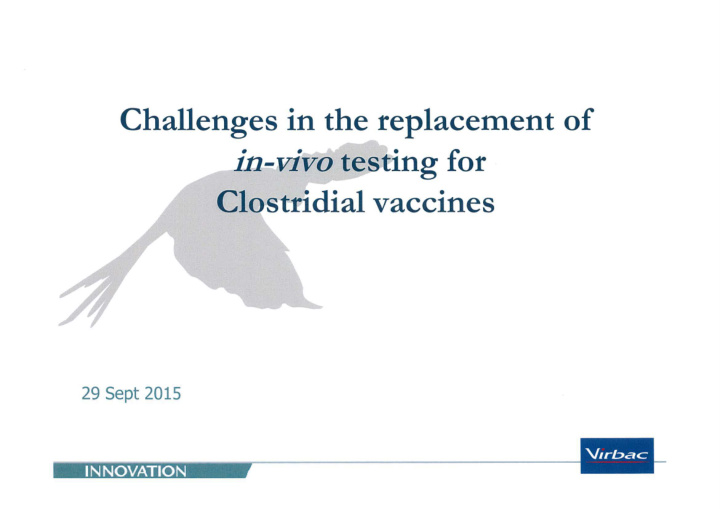



Challenges in the replacement of in-vivo testing for Clostridial vaccines 29 Sept 2015 INNOVATION
• There are two key drivers behind vaccine testing: • Regulatory requirements to ensure safety and efficacy of released product. (APVMA, European Pharmacopoeia) • Process requirements to ensure product is formulated to meet release requirements and that the finished product meets the registered release specification. ~-- ----- INNOVATION
•C novyii •C septicum DOD • C perfringens D (j) Released •C chauveoi •C tetanii ODD •C botulinum C/D Antigen Start growth Inactivation Process in 2 6 9 0 4 Weeks Antigen Potency - Residual Toxicity Antigen Potency - Before Inactivation Demonstrates that the Post Inactivation toxins are inactivated L+ Test Total Combining Power Test Demonstrates that the level of toxin is sufficient prior to Quantifies the to xoid further processing (LD 50) (inactivated toxin) to provide levels for formulation purposes INNOVATION
~ ~ •Multivalent Vaccines •Ranging from 3 in 1 to 6 in 1 Vaccines ± Wormer and/or Vitamin 812 Release for Sale Start and/ or Selenium ding Testing Fill Testi~ I I I I 0 10 12 2 4 6 8 Weeks •Efficacy • Target Safety •Demonstrate using a model system that the product actually raises a response in animals using: •Serological Response Pass Fail - --- - INNOVATION
Current control tests are based largely on lab animal use: mice, guinea pigs and rabbits Goal to achieve within the next 10 years: 80°/o control tests based on in-vitro tests 20% in-vivo tests will be still required: for reagent calibration , in case of significative change of manufacturing process and for testing new vaccines - - -· . ··- INNOVATION
• 14 different vaccines • 10 different antigens, mainly toxoids • Vaccines contain 3 to 7 different antigens • Using oil and aluminium adjuvants • Some supplemented with moxidectin, selenium and/or Vit 812 INNOVATION
Monoclonal antibodies must be specific to the toxoid we want to capture and quantify E.g. Clostridium perfringens D and Corynebacterium pseudotubercu/osis both produce a phospolipase (toxoid) and are in the same vaccine. However the monoclonal is not specific ... Grrrrrr Mab ---- ·- INNOVATION
If the toxoid must be stripped off the adjuvant to quantify it, this introduces more challenges • Must you strip the toxoid, if so, how much? • How reproducible is the stripping process? • Does stripping affect the toxoid structure? Toxoid~ Mab -~ ···-·------- INNOVATION
~ Vaccine assay validation - a challenge Every new assay must be validated • Specificity • Linearity • Limits of quantification • Reproducibility (intra- and interassay) • Accuracy • Robustness And supported by • Controls and standards •SOP • Training of QC staff Toxoid~ • On-going support Mab - -~~- - -- - 1 N NOV AT ION
Every new assay will be tested in parallel with the existing animal test However some vaccines we only make 1-2x/yr ~-~.r-~~ .flQ. .,_ , aM\'lf u. urn "" :i'f'OT \. l'flhl'll£W so testing 20 batches in parallel could take ... . . . Partially resolved by making extra lab batches t l I "T he doctor will be with you in just five more minutes." ~ --- INNOVATION
~ Vaccine assay Registration a challenge Every assay, for each of 10 antigens, will need to be registered against each product they are used in. • Registration cost • Registration risk Mab ~~ - INNOVATION
Recommend
More recommend